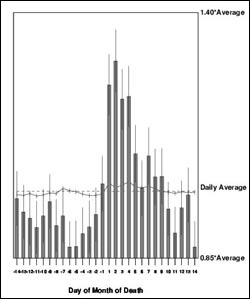New Research Shows Deadly Drug Mistakes Spike At The Start Of Each Month, Suggests Pharmacy Errors

Total numbers of U.S. deaths related to medication errors (± 1.96 standard errors) on each of the first 14 days of the month (days 1 to 14) and the last 14 days of the preceding month (days -14 to -1), 1979-2000. The panel shows data for patients who were dead on arrival and for those who died in the emergency room and as outpatients. The horizontal solid line shows total numbers of deaths from all causes. The dotted line indicates the average number of deaths that would be expected if the numbers did not fluctuate around the first day of the month. The bar graph indicates the total number of deaths from fatal medication errors. The upper limit is set at 1.40 x daily average, whereas the lower limit is set at 0.85 x daily average.
Beware not the ides but the start of March – and April and May and every month. In the first few days of each month, fatalities due to medication errors rise by as much as 25 percent above normal, according to new research by University of California, San Diego sociologist David Phillips.
Published in the January issue of Pharmacotherapy, the journal of the American College of Clinical Pharmacy, the study is the first to document a beginning-of-the-month spike in deaths attributed to mistakes in prescription drugs.
The primary suspect, Phillips says, is a beginning-of-the-month increase in pharmacy workloads and a consequent increase in their error rates. “Government assistance payments to the old, the sick and the poor are typically received at the beginning of each month. Because of this, there is a beginning-of-the-month spike in purchases of prescription medicines,” Phillips says. “Pharmacy workloads go up and – in line with both evidence and experience – error rates go up as well. Our data suggest that the mortality spike occurs at least partly because of this phenomenon.”
Phillips and his coauthors examined all United States death certificates from 1979 through 2000 to analyze the 131,952 deaths classified as fatal poisoning accidents from drugs. A small number, 3.2 percent, of the deaths were from adverse effects of the right drug in the right dose. The vast majority, 96.8 percent, resulted from medication errors – the “wrong drug given or taken,” or “accidental overdose of drug,” or “drug taken inadvertently.”
The study excluded deaths from overdose of street drugs or from intentional poisoning (suicide or homicide).
The beginning-of-the-month mortality spike was particularly pronounced in people for whom the mistakes proved rapidly fatal – those who were dead on arrival at a hospital, died in the emergency department or as outpatients. In this category, deaths jumped by 25 percent above normal.
But could it be that the mortality spike is due not to pharmacy error but simply to the increased number of people buying, then consuming drugs?
To test this, Phillips and coauthors ran analyses on populations of the elderly and the poor. If increased consumption alone was to blame, the researchers reasoned, mortality would be highest in the groups relying on government assistance and therefore purchasing their medicines at the start of the month.
The beginning-of-the-month spike was similar across groups, however. The spike was as evident in the young and well-off as in the elderly and poor, suggesting the problem was at least partly due to an increase in pharmacy error at the beginning of the month.
Phillips notes that the National Center for Health Statistics database used in the study did not contain highly specific clinical information – no information on prescription type, dosage, days supply, etc. – and he urges further research with data richer in this kind of detail.
To reduce the medication-error death rate, Phillips suggests that pharmacies (that don’t already do so) consider increasing staffing levels at the beginning of the month and that government officials consider spreading assistance payments out over the entire month.
“Even in the absence of policy changes or further research,” Phillips says, “it is appropriate for both patients and clinical staff to be especially careful to check the accuracy of their prescriptions at the beginning of each month. If this is done, it seems plausible that some lives will be saved.”
Phillips’ coauthors are Jason R. Jarvinen, sociology student, UCSD, and Rosalie Phillips, executive director of the Tufts Health Care Center, Tufts University
Media Contact
More Information:
http://www.ucsd.eduAll latest news from the category: Health and Medicine
This subject area encompasses research and studies in the field of human medicine.
Among the wide-ranging list of topics covered here are anesthesiology, anatomy, surgery, human genetics, hygiene and environmental medicine, internal medicine, neurology, pharmacology, physiology, urology and dental medicine.
Newest articles

“Nanostitches” enable lighter and tougher composite materials
In research that may lead to next-generation airplanes and spacecraft, MIT engineers used carbon nanotubes to prevent cracking in multilayered composites. To save on fuel and reduce aircraft emissions, engineers…

Trash to treasure
Researchers turn metal waste into catalyst for hydrogen. Scientists have found a way to transform metal waste into a highly efficient catalyst to make hydrogen from water, a discovery that…

Real-time detection of infectious disease viruses
… by searching for molecular fingerprinting. A research team consisting of Professor Kyoung-Duck Park and Taeyoung Moon and Huitae Joo, PhD candidates, from the Department of Physics at Pohang University…





















